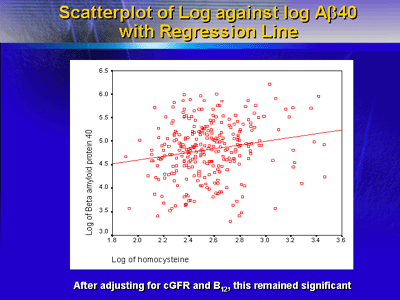| Researchers
found a positive association between beta-amyloid and homocysteine
in older men that did not exhibit any signs or symptoms of Alzheimer’s
disease. This suggests homocysteine may play a role in production
or accumulation of beta-amyloid. The finding may strengthen
the hypothesis that interventions to lower homocysteine in healthy
individuals could have a beneficial effect on cognition.
Dr. Flicker and colleagues have performed
an analysis of genetic factors and specific proteins associated
with cognition and depression in a group of 299 healthy older
men taking part in a large, ongoing cohort study. These men,
aged 75 years or older, were hypertensive or had previously
received treatment for hypertension. None had depression or
cognitive impairment.
As part of the study, investigators looked
at levels of beta-amyloid peptide, which are the primary components
of the amyloid plaques that characterize Alzheimer’s disease.
Researchers believe the production of amyloid protein is the
first step in the pathogenesis of Alzheimer’s disease. Previous
investigations have found a correlation between plasma levels
of beta-amyloid and presence of Alzheimer’s disease.
Investigators also quantified levels of homocysteine,
which in high levels is both prothrombotic and atherogenic,
in relation to a common genetic mutation of the MTHFR gene.
This mutation reduces enzyme activity, which can result in
increased serum concentrations of homocysteine. It is still
unclear what effect this mutation has on risk of dementia
or depression.
The mean age of men in this investigation
was 78.9 years, and the mean Mini-Mental State Exam score
was 27.6. Homocysteine levels ranged from 6.7 to 70.5 µmol/L
(mean of 13.5 µmol/L). Levels of Aβ40, one of the predominant
beta-amyloid types, ranged from 16.2 to 403.3 pg/mL (mean
143 pg/mL).
The scatterplot of log homocysteine against
log Aβ40 shows an association between serum levels of homocysteine
and serum levels of the amyloid protein. Both of these proteins
are actually related to renal function; if renal function
deteriorates, serum levels tend to rise. However, even after
investigators adjusted for renal function (calculated glomerular
filtration rate), this association remained significant.

The study also had some negative findings.
Investigators also looked at apolipoprotein E epsilon 4 (APOE
E4), an established risk factor for Alzheimer’s disease. However,
they found no relationship between the APOE E4 allele and
cognition. This is probably because the study included only
cognitively intact subjects. The association between APOE
E4 and cognition could be most evident in cognitively impaired
individuals.
They also found no effect of the MTHFR gene
mutation on homocysteine levels. This could be because intrinsic
and environmental factors diluted the effect of this polymorphism
in these older men. Factors that may be more important for
homocysteine levels in older men include B12 deficiency, renal
dysfunction and cell aging.
On the other hand, the positive correlation
they did find between homocysteine and amyloid protein levels
could be an important finding. In these older men, who had
no major health problems besides hypertension, the relationship
was significant.
The finding strengthens the hypothesis that
homocysteine is involved in the pathogenesis of Alzheimer’s
disease. The finding, if corroborated by other studies, could
also have implications for prevention, since specific interventions
can reduce homocysteine levels. Dr. Flicker said that an intervention
to reduce homocysteine might be started before individuals
have any evidence of Alzheimer’s disease.
One approach to lowering homocysteine is with
vitamins such as folate and B12. Dr. Flicker and colleagues
are completing a trial looking at the effects of homocysteine-lowering
vitamins on the mental health of older men. Results, which
should be available in about one year, could provide further
evidence to support the link between homocysteine and cognition
levels in healthy older individuals.
|